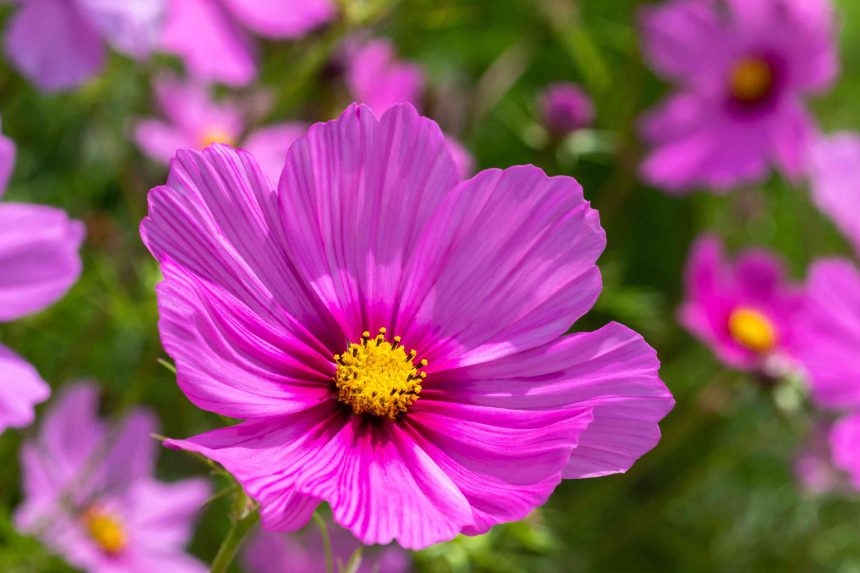If you live in a region where the soil is sandy, it can be challenging to grow anything unless you pick the right plants. That’s because sandy soil is low in nutrients, doesn’t retain moisture well, and makes it difficult for roots to establish. However, there are some tough plants that thrive in sandy soil that you can grow to get your yard flourishing with beautiful blooms and foliage.
Below, we’ve rounded up some of the best flowers and plants that will not only survive but thrive in sandy soil.
Coneflowers (Echinacea purpurea)
Getty Images
Coneflowers will add a playful pop of color to your yard. Native coneflowers come in shades of purple and yellow, while hybrid types can be red, orange, pink, or multi-colored. They are low-maintenance, drought-tolerant, and thrive in sandy soil. These beauties can grow up to 3 feet tall and 2 feet wide. Plus, their bright blooms attract bees and butterflies, making them ideal for your pollinator garden.
Sun Exposure: Full Sun
USDA Zones: 3 through 8
English Lavender (Lavandula angustifolia)
Getty Images
There are actually over 450 varieties of lavender in the world. Lavender is a perennial plant that is part of the mint family, and one of the most popular types is English lavender. This plant is a breathtaking beauty that produces dark purple flowers and features blue-green foliage. It grows up to 2 to 3 feet tall and wide, and since it prefers well-drained soil, it’s perfect to plant in sandy areas. Its calming, sweet scent promotes relaxation for people but is also a favorite of pollinators.
Sun Exposure: Full Sun
USDA Zones: 5 through 9
Bearded Irises (Iris germanica)
Getty Images
Bearded irises come in a variety of vibrant colors, including yellow, white, blue, purple, and even multi-colored combinations. The flowers have an eye-catching pattern that looks like a “beard,” which is a fuzzy area on the petals that is typically a different shade. The plant’s frilly ruffled petals are nothing short of whimsical. These irises can reach between 1 and 3 feet tall and have long sword-shaped leaves that grow in a fan pattern.
While this is one of the prettiest plants that can thrive in sandy soil, you should avoid adding it to your outdoor space if you have pets because it is toxic to them. Always research plants before planting to ensure they aren’t going to harm your pets.
Sun Exposure: Full Sun
USDA Zones: 3 through 9
Black-Eyed Susans (Rudbeckia hirta)
Getty Images
It’s vital to pick plants that thrive in sandy soil that are also beneficial to wildlife. While there are many plants to choose from, some are invasive and make it hard for native plants to thrive, which upsets the balance of biodiversity.
Wildflowers like black-eyed Susans are native to the United States and help provide food for birds, bees, and butterflies. These bright, cheery flowers come in various bold colors, are super resilient, and grow up to 3 feet tall.
Sun Exposure: Full Sun
USDA Zones: 3 through 10
Cosmos (Cosmos bipinnatus)
Getty Images
These charming wildflowers are also native to the U.S. and come in a variety of colors, including pink, white, orange, red, and more. Cosmos feature beautiful blue-green foliage and can grow 1 to 6 feet tall. Although they’re annual flowers, they self-seed, allowing them to grow back the following year.
These hardy wildflowers are easy to care for and are the prime pick for cottage gardens. You can also use the chaos gardening method with wildflowers such as cosmos, which involves scattering seeds around to see what grows.
Sun Exposure: Full Sun (Can tolerate partial shade but needs direct light for optimal growth)
USDA Zones: 2 through 11
Hens and Chicks Succulents (Sempervivum)
Getty Images
Beginner gardeners adore succulents because they are easy to care for and can thrive on neglect. Sempervivum succulents can grow in well-draining sandy soil and are also frost tolerant. They have thick, fleshy leaves that can be rounded or pointed and grow like rosettes.
This particular type of succulent can actually bloom flowers if it’s healthy.
Sempervivum can grow 6 to 12 inches tall and 6 to 18 inches wide. These impressive plants can self-propagate and continue to spread out where they are planted.
Sun Exposure: Full Sun
USDA Zones: 3 through 11
Thyme (Thymus vulgaris)
Getty Images
Thyme is one of the best things you can plant if you are trying to create an edible landscape. Thyme is a tasty herb that can be grown indoors and outdoors in sandy soil. It also produces tiny tubular flowers, and the colors can be white, pink, or purple, depending on the type. It can grow between 6 to 12 inches in height and width. Another perk of this plant is that pollinators favor it, and it returns yearly.
Sun Exposure: Full Sun
USDA Zones: 5 to 9







